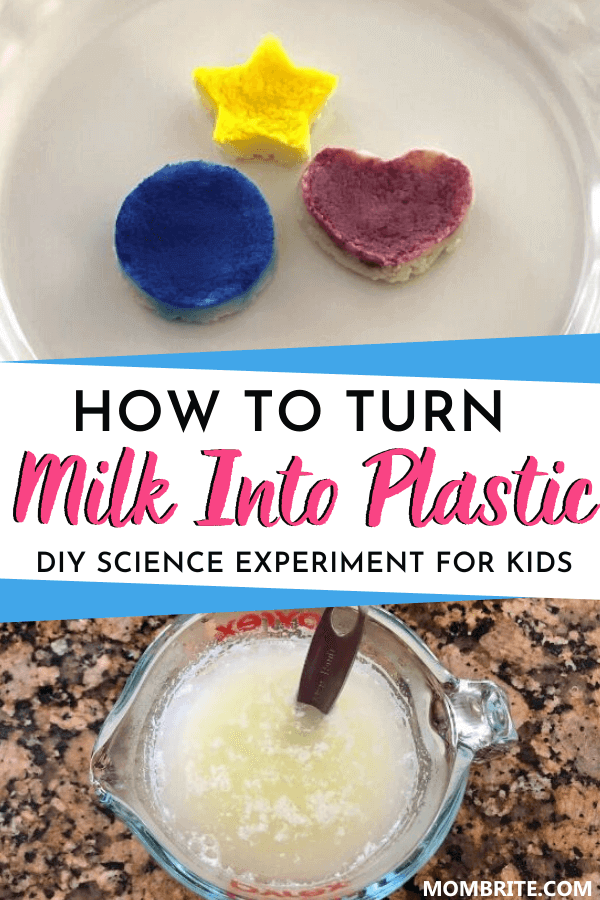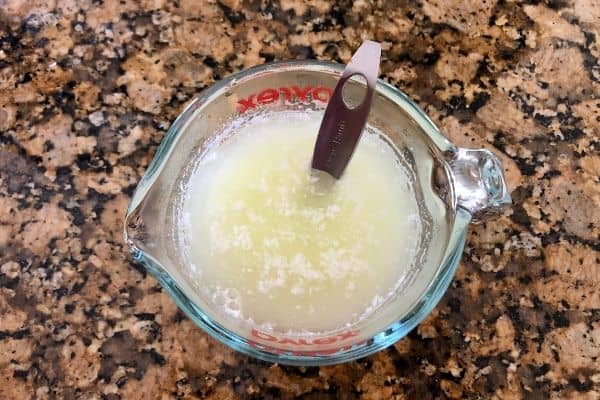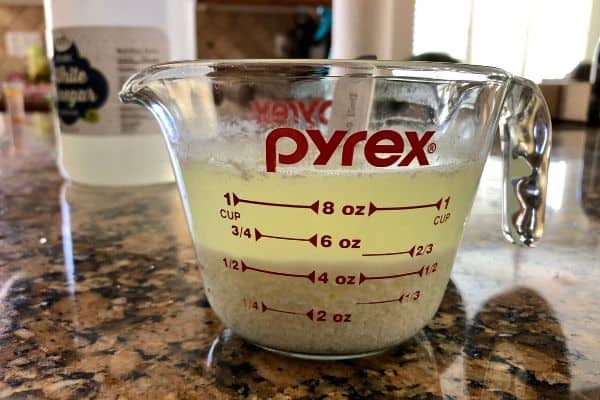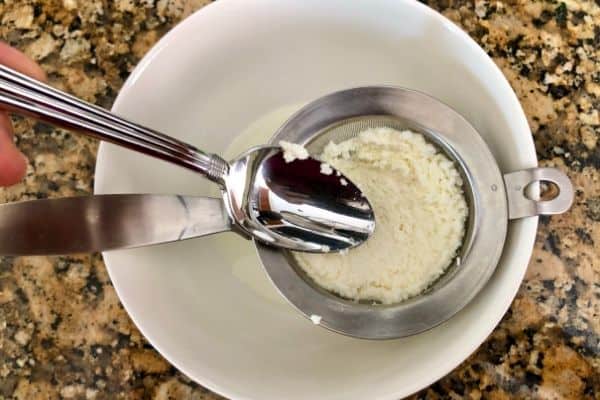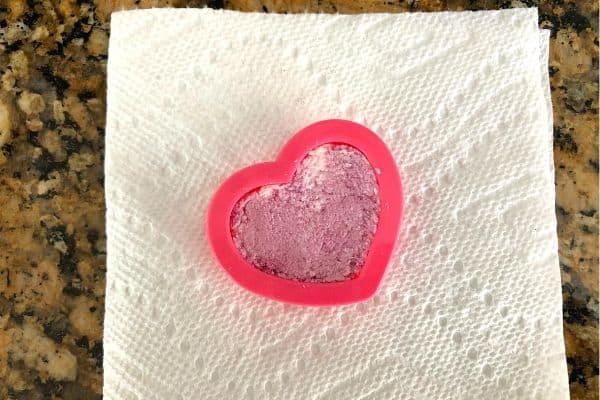Learn how you can turn milk into plastic with just a few simple steps. This food science experiment will produce a chemical reaction that will blow your kids’ minds!
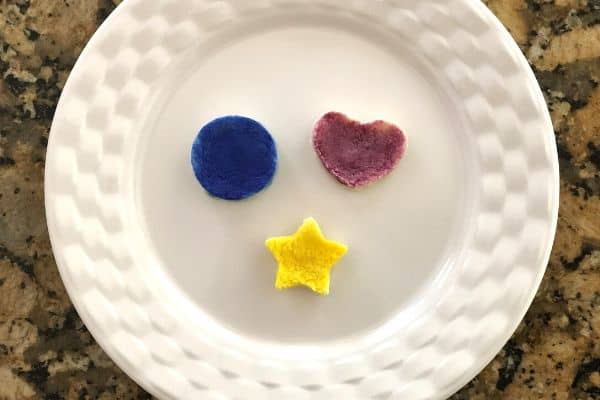
Talk about mind-blowing food science! How can you turn milk, a dairy product, into plastic?
When I told my son that we are about to transform milk into plastic, he didn’t believe me. But as soon as we added vinegar to the milk, he changed his mind.
Are you still skeptical? Let me show you how you can do this science experiment and surprise your kids.
How to Turn Milk into Plastic
Materials:
- Milk
- White vinegar
- Measuring cup
- Measuring spoon
- Spoon
- Paper towels
- Cookie-cutters
- Optional: food coloring
Steps:
- Heat one cup of milk in the microwave until it’s hot, but not boiling.
- Add 4 teaspoons of white vinegar to the milk. You should see curds, or white clumps, form immediately.
- Stir the mixture for about a minute.
- Let the mixture sit until it cools. Show your kid how the liquid separates from the curd.
- Pour the mixture through a strainer to drain the liquid. The white clumps should stay in the strainer. You can also save the liquid, which you will learn below that it’s whey.
- Use a spoon and push down on the clumps to get as much liquid out as possible.
- Transfer the curds over to some paper towels and press down on them to get all the excess liquid out.
- Optional: Add food coloring to the curds. I added a couple of drops of food coloring to the curds after I put them in the cookie-cutter because I wanted to make different colored plastics. But if you just want one color, you can add it now and then knead the curds to blend.
- Use your hand or spoon, fill a cookie-cutter with the curd and press down gently.
- Leave the wet curds to dry for about 2 nights.
- Optional: paint the final products!
I know what some of you are thinking – this is how you make cottage cheese!
It’s true, to make cottage cheese, you take the same steps as making plastic. You just would want to eat the cottage cheese right away after you drain the whey. You also might want to rinse the curds under cold water to get all the acid out.
So yes, when you eat cottage cheese, you are eating curds of casein protein. We are just taking the extra step to dry it out
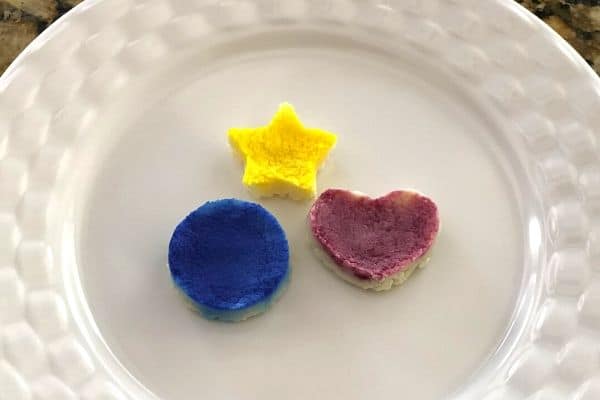
My son did NOT like the vinegar smell when we were pouring it into the milk. Don’t worry, after the casein plastic dries, there is no smell odor.
The Science Behind Making Plastic from Milk
How in the world are we getting plastic from milk?
Milk contains a protein called casein. Each casein is a molecule is a monomer and a chain of casein monomers is a polymer.
When you lower the PH level of milk by adding vinegar to it, the casein protein molecules start to unwind. They reorganize into a long chain of casein monomers and curdle the milk.
At this point, you can separate the curds from the liquid, which is whey. Instead of pouring whey down the drain, you can save it and use it in soups and stocks. If you don’t feel comfortable consuming it, you can always pour it in your garden to give your plants extra nutrients.
Science Extensions to Try
Since it’s so easy to make plastic from milk, you can do it again and again and test out the following:
- Use milk with a different percentage of fat. I used 2% milk, but you can try using whole or even heavy cream. Compare how much curd you get and what the curds feel and look like.
- Try adding more or less vinegar to the milk. Does more vinegar yield more curds? Does vinegar affect the look and feel of the casein plastic?
- Instead of white vinegar, try curdling the milk with other acidic substances like lemon juice or apple cider vinegar. Can you curdle the milk with these acids?
- Instead of using hot milk for this science experiment, try using hotter or colder milk. How does the temperature of the milk affect how much casein plastic you can make? We actually made the mistake of using cold milk when we first tried the experiment and we did not see any curds forming for at least 30 minutes.
Final Thoughts on Turning Milk into Plastic
Before you go, I want to address some of the most frequently asked questions:
- Can you eat casein plastic?
As I mentioned above, this experiment is similar to how you would make cottage cheese at home. So yes, you can eat the casein plastic, but I am not sure how tasty it would be after it dried. Maybe give it a taste before you put it in the cookie-cutter.
Also, please DON’T go around eating plastic products made out of milk protein. Those items go through more processing after drying to become the products that they are today.
- How long will milk plastic last?
Plastic is durable, and therefore your milk plastic should last a long time. We are talking about years!
You can punch a hole in your casein plastic and make it into an ornament. You can paint it whatever way you want.
I hope your kids are wowed by this experiment! Mine couldn’t believe their eyes!
YOU MAY LIKE:
